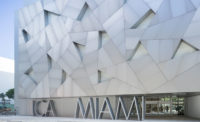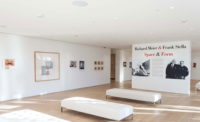Much of Miami is white—even Herzog & de Meuron's newest building, made of concrete like so much of their recent work, is painted white. (More on that later.) But a diverse crowd turned out for a panel discussion at Design Miami called “Rethinking the City Through Blackness.” The event was part of a series organized by Milton S.F. Curry, dean of U.S.C. School of Architecture, and titled “Spatializing Blackness.”
Curry, as moderator, started things off by quoting W.E.B. Du Bois: “I do not care a damn for any art that is not used for propaganda.”David Adjaye, perhaps uncomfortable being used for propaganda, warmed to the topic slowly. Showing photos of his work, he spoke of the “need to create a body of evidence” that can used for “recoding the system.” So he must have been very pleased when artist Amanda Williams, who trained as an architect and will be one of the U.S. representatives at the 2018 Venice Architecture Biennale—said that “when I teach, I casually introduce David’s work as part of the canon.”
Germane Barnes, who works as an architect and planner in Opa-locka, a city just north of Miami, argued forcefully for community involvement in design decisions. “Spatializing blackness means bringing [black people] to the table and taking notes,” he said to the audience and his fellow panelists. But Williams, who works mainly as an artist, said that for her most famous project, in which she covered eight abandoned houses on the south side of Chicago in bright colors, “I didn’t ask for permission. I didn’t hold meetings.” Williams suggested that her own move from architecture to art was liberating. “I naively assumed I could go to architecture school and fix everything. Architects need to get over ourselves.”
As an artist, Williams said, "I am a community."









